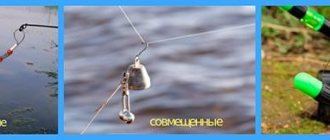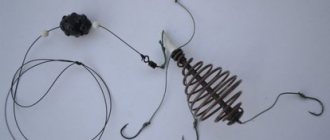So, it’s time to figure out what kind of feeder alarms there are. Their types, application features, and how to make homemade bite alarms for the feeder at home.
All feeder alarms can be divided into three types: sound, visual and combined. But such a classification will be quite superficial, since the robots and designs are the same in principle, the sound alarms can be very different.
Feeder alarms based on their operating principle are:
- Pendulum;
- Light (fireflies)
- Nods;
- Sound (bells, bells, rattles);
- Electronic
Pendulum signaling devices for feeder
The most common pendulum feeder alarm (Fig. 1) is a tube, which at one end has a small loop attached to the first ring from the reel, and at the second end there is a barrel, from which comes a large loop that clings to the fishing line.
Pendulum signaling device
After casting, tighten the line just enough so that the bite alarm sag a little. During a bite: pull (the fish pulls the tackle from the shore) - the alarm goes up, release (the fish pulls the tackle towards the shore) - it goes down. If this pendulum alarm breaks, do not rush to get upset, keep a barrel of it and then I will tell you how to make a homemade bite alarm for a feeder (swinger) .
Some fishermen, when the bite is weak, attach an audible alarm to a pendulum one. The only condition is that the sound alarm must be light. Such alarms are preferable in a feeder for beginners because they have a low price.

Pendulum
When buying a pendulum alarm, you need to pay attention to the fact that there are holes on the barrel of the alarm; they are needed in order to insert a firefly ampoule during night fishing. This ampoule contains a chemical element, and when we break it, it will begin to glow, so that we can see the bite. They are usually sold two per pack. This ampoule lasts for one night, and they are inexpensive.
Previously, we used a piece of clay or earth attached to a fishing line, a twig, or a clothespin as a pendulum signaling device.
DIY pendulum
Take a wire 30 cm long (the wire should bend easily and not break). We bend one edge of the wire, making a loop with a diameter of 1 cm, but so that after the loop you still have 1 cm of wire left, we place a juice tube 10-15 cm long on the wire. Then we put a float or kinder surprise on the tube rod, having previously drilled there is a longitudinal hole in them. We install it so that the float sits rigidly, but at the same time the tube does not stick out of it. Then, on the wire, we put another piece of the tube, 2 cm long, and bend the wire so as to make a loop 2-3 cm long, cut off the excess wire so that after the loop we have another 1 cm of wire left. Then we bend the resulting loop at an angle of 90 degrees to the rest of the alarm body.
Arriving at the reservoir, we will attach a small loop to the first pass ring from the coil, then we will hide a piece of wire 1 cm long into the body of the tube, fixing our alarm. Then we pass the fishing line through a large ring and again hide the free centimeter section in the tube, finally fixing our homemade feeder alarm. In order to remove it, we remove the short ends of the wire from the tubes.
A very quick option is to take a corrugated juice tube, close its holes with a stopper made of polystyrene foam, thread a Kinder Surprise barrel or an old float into it, then attach plastic-coated paper clips to the edges. Our alarm is ready.
Electronic bite alarms
- “Newfangled things” have different ways of notifying you of a possible trophy. An electronic bite alarm for a feeder can be: acoustic;
- light;
- or combined.

Electronic bite alarms
Signals are transmitted directly and remotely. The products are resistant to humidity, shock loads, and temperature changes.
What are they made of?
Miniature devices consist of a body, inside of which there is a “filling”:
- the electronic unit;
- two LEDs;
- speaker;
- oval groove for the body of the fishing rod;
- two rollers for fixing the cord.
The model is equipped with a sound volume control.
How does an electronic bite alarm work?
You cast the tackle to the desired area of the reservoir: the rod lies in the designated recess, the fishing line is fixed with rollers.
When the fish is activated, the fishing line, starting to move, closes a circuit inside the structure: a sound or light impulse is obtained that will help you react in time.
Types of electronic signaling devices
The gadgets are mounted on the first leg of the blank or on supports under the rods, and respond to the vibration of the feeder or the tension of the fishing line. An electronic bite alarm for the feeder can be equipped with a pager alert.
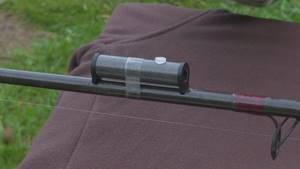
"Megatex Jay 3"
Popular models:
- "Strike Alert" The compact device is indispensable in conditions of poor visibility; it is mounted on the top of the feeder. When nothing happens on the pond, the green diode lights up, but when a fish swallows the bait, the light changes to red. The trembling of the rod from the wind confuses the device, and then false signals are sent.
- "Megatex Jay 3". The Russian design includes 5 levels of sensitivity adjustment of the feeder tip. The first one works in a calm environment, when there is no wind or current. If conditions change, other levels are chosen. You can also change the tone of the sound, set your favorite melody from those stored in the device.
- "Barracuda T5". This device has a rich set of settings and is also used as a stand for a feeder.
- Mifine. The portable indicator is powered by AA batteries. The waterproof case has a stylish design. The use of an electronic signaling device for the Mifina feeder is possible in combination with a swinger.
All electronic devices are mounted on the first leg of the rod blank.
Your question to an expert
Mikhail Konovalov
Amateur fisherman with 20 years of experience
Ask a Question
Tips for use
If handled properly, devices last 4-5 years. Tips for using electronic bite indicators:
- Operation of the feeder bite alarm begins with studying the instructions. When using, it is important to comply with the manufacturer's requirements.
- Protect the device from getting wet and mechanical damage.
- Study the functions of the alarm, use its capabilities depending on the fishing conditions.
- Adjust the sound volume: Fishing loves silence.
- Carry a supply of AA batteries with you so that in a critical situation you will not be left without an alarm device.
- On different fishing rods, install bite detectors with a different tone so as not to confuse fishing gear.
- To install a bite alarm on the feeder, try on rubber seals: this way the products will not slide along the form.

Operating a bite alarm on a feeder
Electronic alarms are useless when actively fishing for small fish. Mount devices for hunting large trophy specimens.
Feeder alarm (Swinger)
Unlike a conventional pendulum, such a feeder alarm does not hang on the rod's guides, reducing casting distance and creating the likelihood that the tackle will get tangled. And they don’t sway that much in the wind.
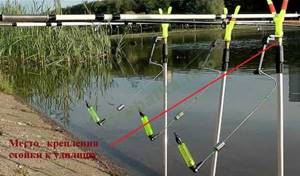
Swinger
The design of these alarms is as follows: one edge has a passage ring, through which the swinger is attached to the rod post. The stand must be collapsible. The rod is removable, and at the bottom there is a tube into which we thread the edge of the swinger, then we insert the rod back into the rack. Well, this is ideal, there are a variety of racks and some provide another mounting option, the main thing is that your swinger is firmly fixed. Then on the opposite edge we have a clamp through which we pass the fishing line. The clamp has a nut, with the help of which we can regulate the clamping force of the fishing line. Also, most swingers are equipped with barrels where you can insert a firefly. Some swingers have a weight to adjust the weight of the alarm; if the weight is moved closer, then light pulls will be unnoticeable, thus we cut off false bites; if we move the weight close to the stand, then our tackle becomes more sensitive.

Swinger
For convenience (so as not to stand and look at it all the time), a bell, a bell is attached to the swinger, or it comes in conjunction with an electronic feeder alarm.
DIY swinger
It’s very easy to make a homemade bite alarm for a feeder (swinger). For this we will need a barrel from a broken alarm we have, you can also take a yellow barrel from a Kinder Surprise and make holes in it at the top and bottom. Then, we take a piece of wire, bend it in half and insert it into the central hole of the barrel, so that on one side we have a small loop, and on the other two protruding edges of the wire 1 cm long. We put two beads on them. We attach a piece of nylon thread to the loop.
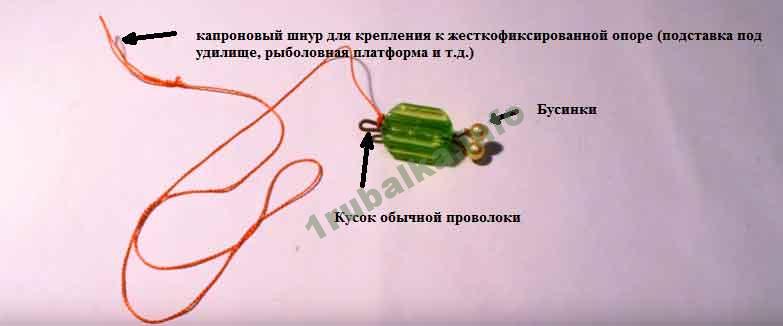
Homemade swinger
The operating principle of such a feeder alarm is simple. We rigidly attach the free end of the nylon thread to the rod stand or fishing platform. Then, after throwing the tackle, we take our barrel and hook it onto the fishing line, passing it between two beads. When we bite, we hook, the nylon thread is stretched and the feeder alarm flies off the line, so we can safely reel in the tackle. Having recasted, we again hooked it to the fishing line. You can attach a bell to the loop, and our alarm, in addition to being visual, will also become audible, and if you also insert a firefly ampoule into the side hole, then it will be very difficult to miss a bite at night.
Light bite alarms for feeder
Firefly feeder alarm. As mentioned earlier, there are two of them in the package, plus a casing (tube) for attaching this alarm to the float. Many sound and pendulum alarms initially have holes for attaching such fireflies, but it is only necessary to select a firefly to match the diameter of such alarms for the feeder. The diameter of the firefly can be seen on the packaging, but the hole diameter of other alarms is not always written on the body, and it is better to take them with you to the store and there, with the support of the seller, choose the firefly that suits you.
In order to activate the indicator light for the feeder, it must be broken. There is a liquid inside the flask, and in the center, a tube with a chemical element, the tube breaks, the chemical element mixes with the liquid and begins to give light, for greater efficiency the firefly must be shaken.
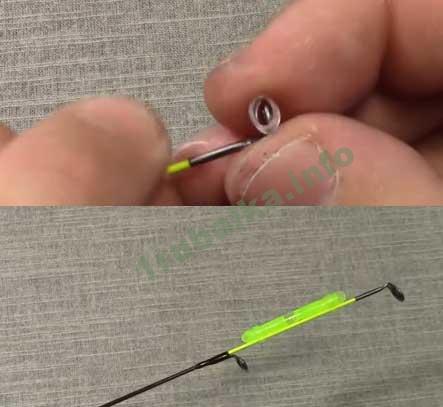
Firefly, attached to the tip of a whip
If you are used to detecting bites by the sensitive tip of the tip, then this firefly can be attached to it using an adapter. True, there is one thing here: the adapter cannot be attached to the edge of the top, since it will dangle. It will be possible to secure it normally only closer to the middle. Of course, you will see bites, but this is less effective than if it was located on the most sensitive place of the rod - the tip of the whip. It is in this position that you will be able to see even the weakest stretches.
Therefore, we take scissors and cut off two rings 3-4 mm thick from the cambric. Then we thread these rings through the edge of the top. You need to put the rings on the top ring from the bottom, the tube is elastic and stretches quite well, so you won’t break the ring. Then the firefly feeder alarm is rigidly fixed on the tip of the rod using these rings.
Inexpensive electronic firefly feeder alarms are also available for sale. It is attached to the tip of the rod and in the working position it lights up green; when a fish attacks the bait, it starts flashing red. It is equipped with a detector that recognizes waves, wind and current. Battery operated.
Mechanical alarms
The design of such products does not include batteries or radio control. All work is based on physical laws.
Swinger
It looks like a bulky structure with a plastic flag equipped with a loop. A cord is threaded through this loop. Another component of the system is a long lever with a 100-gram weight, on which there is a bracket that is attached to a support under the feeder.
When the fish starts to bite, the cord is pulled tight and the weight moves along the lever towards the swinger. All the action happens before your eyes, and you can instantly react to the activity of the fish.
Hanger
Among mechanical bite detection devices, hangers are the most sensitive. Structurally, it is a plastic oval with a line clamp at the top. Weights are attached to the bottom to tighten the cord. The product is fixed to the front crossbar using a chain.
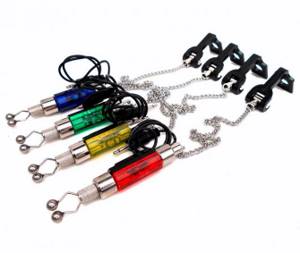
Hanger
At rapid speeds and long distances, the weight of the weights is not enough, so manufacturers make additional weights that can be purchased separately.
How to make your own mechanical alarm
A steel wire 25-30 cm long and several plastic plugs will make an excellent guard. Bend the wire in 3 places. The angle of one fold should be straight: this side will attach the device to the rod with electrical tape.
Heat one end of the wire on a fire, put on plastic plugs. Attach the straight part to the fishing rod, and place the other, curved part on the fishing line. As soon as the fish touches the hook, the curved section will jump off the line: a pendulum effect will be obtained. All you have to do is hook the fish.
Feeder signal nod
A striking example of this signaling device is the very sensitive tip of the feeder rod (whip, feeder tip, quivertip, can be called differently, the main thing is that its sensitivity is sufficient to transmit a bite signal). When we cast the tackle and put the rod on the stand, we reel in the line so that the whip is a little tight, and now when the fish is pulled, it will bend even more, and when released, it will straighten out.
Homemade feeder bite alarm nod
But it is not always possible to use a rod with a sensitive tip, and in general, due to budget constraints, many anglers use a regular spinning rod . In these cases, fishermen often equip their forms with homemade signaling devices, which are called “side nod” . This nod is attached between the coil and the first ring. Fishing stores sell metal nods for winter fishing rods with an elastic band that has three holes, one for attaching the elastic to the rod, the second for the nod and the third for the fishing line. We attach such an elastic band, using electrical tape or adhesive tape (3-4 turns), to the rod at a distance of 10-15 cm from the reel, so that when we insert the nod, it is perpendicular
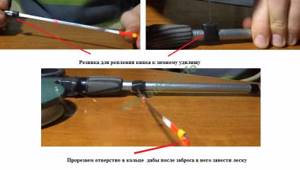
Side nod
the rod, first on an elastic band, in the place for attaching the nod, cut through the electrical tape with a knife. At the opposite end of the nod we have a ring, we cut a small hole in it so that after casting we can wind the line. The tackle is ready. To better secure the fishing line on the rod, you can make an additional hook on the nod itself. It is made from ordinary wire, one edge is bent in the shape of a hook, the second is threaded into the nod ring and bent. And with the help of pliers we firmly fix it. Then, take another piece of wire and fold it in half, then bend one edge. We attach the resulting second hook to the rod as in Fig. 2. When attaching it to the rod, in order not to damage the form, you must first wrap two or three turns of electrical tape on it, and then attach the hook to it.

Side nod fig. 2
You can also use any other soft tube 4-5 cm long and 2-3 mm in diameter to make a similar feeder alarm. Then we take our nod, a springy wire 15-20 cm long is suitable for the role of a nod, just don’t take it too hard, otherwise the sensitivity will be weak. From one end, bend the edge 3-4 cm at an angle of 90 degrees and fasten it into the tube. At the opposite end we make a bend shaped like the letter Z, each bend of such a hook is 1 cm long. After we have cast, we pull the fishing line and put it into the Z-shaped hook of the alarm. For better visualization, we need to paint our hook in a bright color.
Sound bite alarms for feeder bells (bells)
We have already talked a little about them earlier; these are simple devices in design, consisting of a clip-mount and a sound element (although bells can only have a throughput hole). They are attached to the edge of the rod.

Bell and tambourine
In order for the sound feeder alarm to work, you need to make the tip of the rod taut and then when you bite (pulling or releasing), the tip will begin to bend and the bell will give a signal that it’s time to hook. Unfortunately, this method of fastening is far from perfect, since when biting there is a possibility that the bell will jam the line or fly off the rod during fishing. Therefore, it would be more effective to take an elastic band, attach one edge to the rod stand at a distance of 20 cm from its top edge, the second edge directly or through a carabiner to the bell throughput ring, on the other side we attach a hook and hook it to the fishing line near the reel. If you are attaching a bell, or the bell does not have a separate access ring, but only a clip, then the leg of the hook or carabiner must be of the required length and thickness so that the clip can be fixed to it. The length of the elastic must be selected so that the attached hook pulls back the fishing line by several centimeters. After hooking, make sure that the hook has come off the line, and only then start reeling out the tackle.
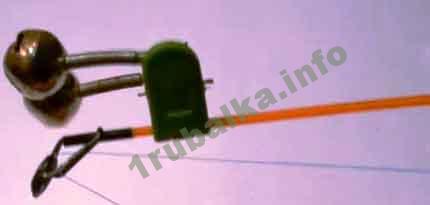
Bubinets
Now the feeder signaling bell will not be lost during casting, since it will be installed later. If you are going to fish with several rods, then it is better to use several bells with different tones.
In order to give the bells maximum sensitivity, you need to stretch the springs.
DIY bell
You can make bells yourself; they are two balls, inside of which there is a bearing, and when it hits the wall of the ball, a sound is produced. So, we take two spiral wires, about 10 cm long, and attach them to our balls. Then we attach the free ends of the wire to a clothespin or crocodile clip. That's all. Although these homemade bite alarms for feeders are very rare, since they are easier to buy at any fishing store for a small price.
Why do you need a bite alarm?
Since the invention of the bottom fishing rod, an object whose density is less than water has been attached to a cord or fishing line. Perhaps it was a stick that stayed afloat until the fish swallowed the hook with the bait. Then wood, cork, reeds, and bird feathers were used. When plastic was invented, products became not only functional, but also attractive, bright, and took on intricate shapes.
A float standing vertically in the water has two tasks: to hold the hook at the desired depth and to communicate the fish’s intentions to take the bait. In the case of feeder fishing, the hook does not need to be fixed.

Bite alarm
In fog or when hunting at night, you may not be able to see the rod tip. You need a bite alarm for the feeder in order to respond in time to a situation when an underwater inhabitant carefully tries the bait or swallows it.
For an effective fishing session, you can take 3-4 fishing rods with you and keep them on a stand. It is impossible to keep track of all the feeders without some kind of sign from them. This is where inventions come to the rescue in the form of a feeder alarm. The devices will notify you with audio signals, or you will visually observe every movement at the tip of the feeder. Fishing equipment can be made in mechanical or electronic versions.
